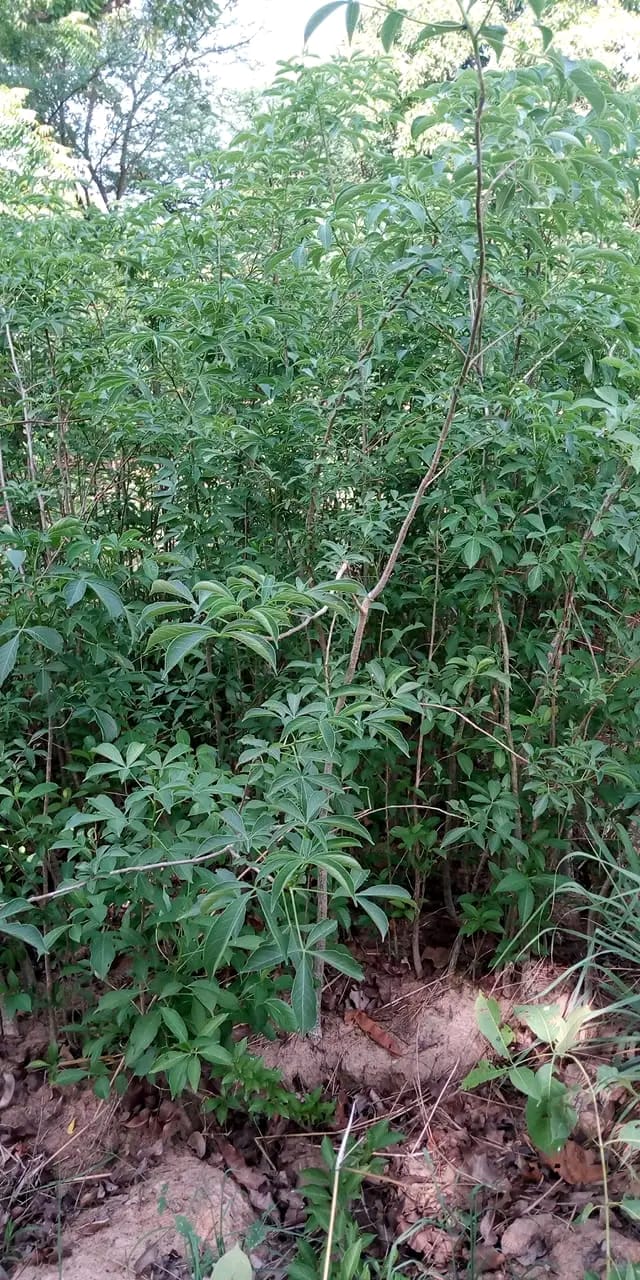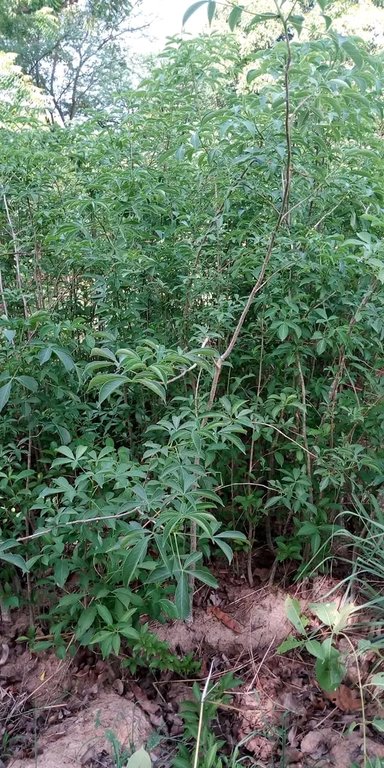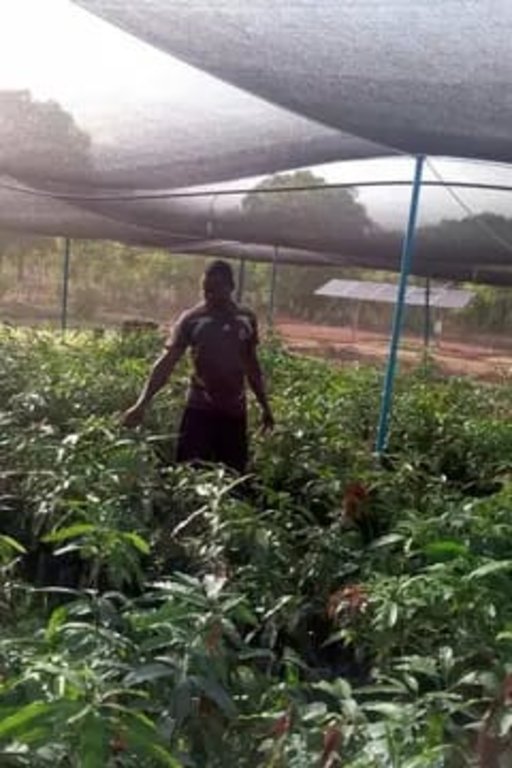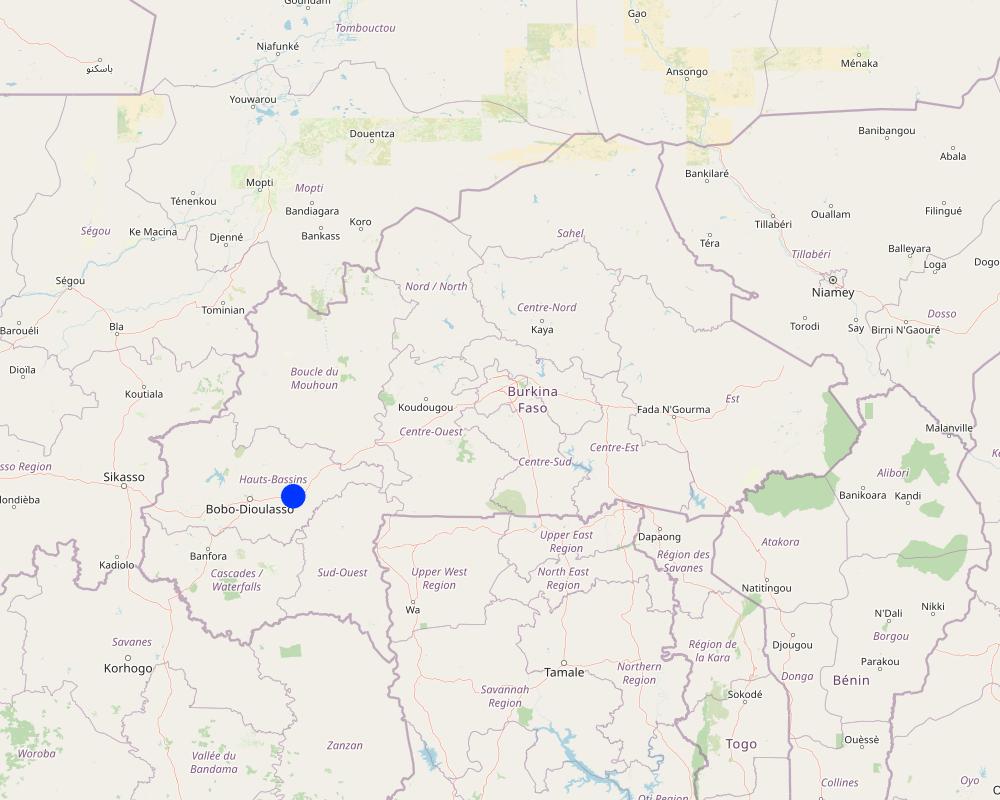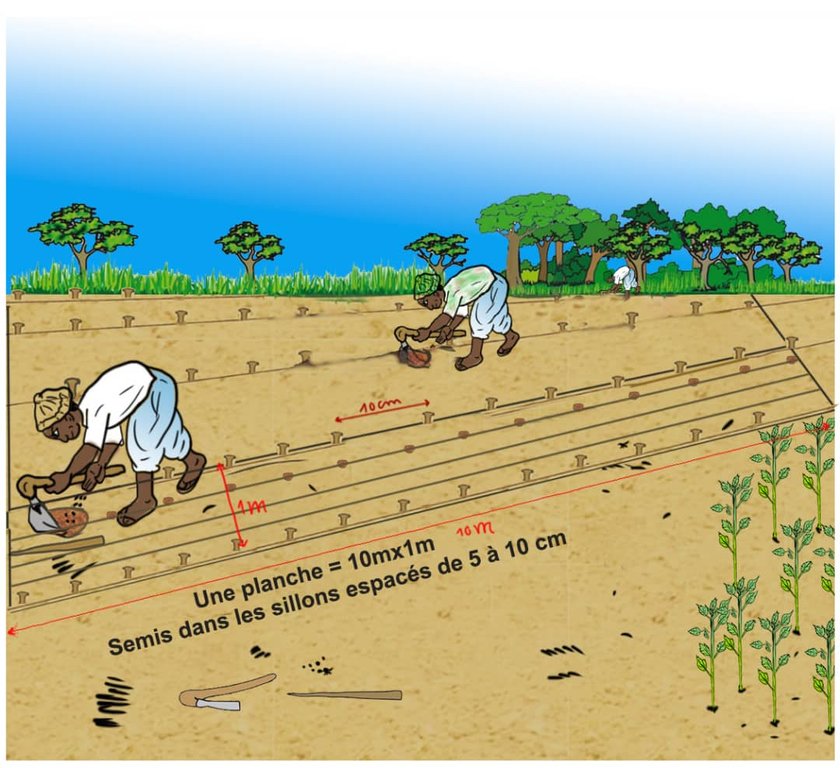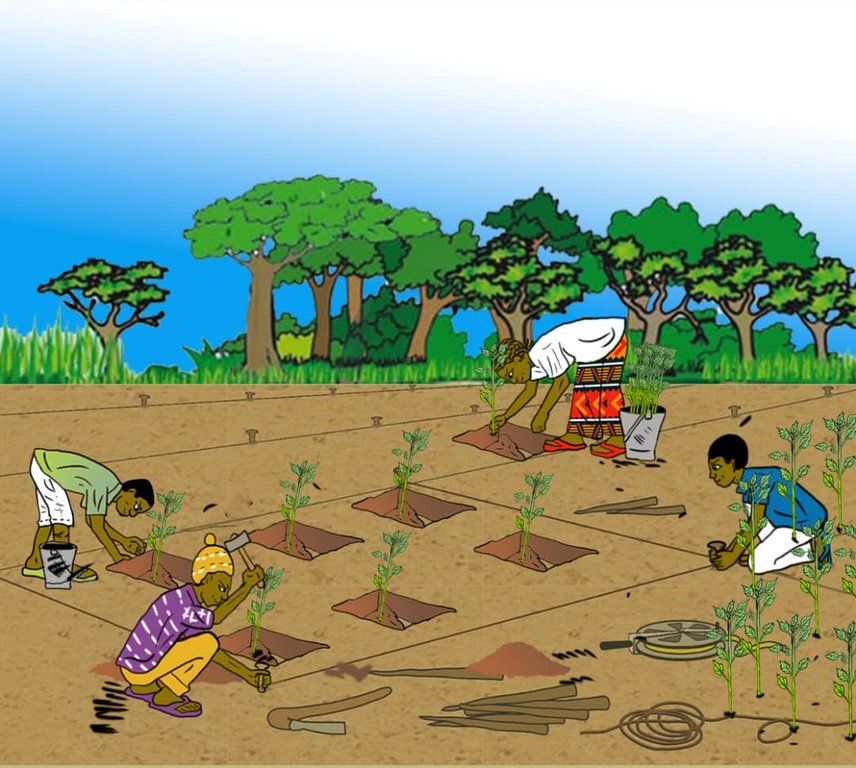Producing and Using Agroforestry Tree Seedlings [Burkina Faso]
- Creation:
- Update:
- Compiler: Moussa ABOU
- Editors: Brice Sosthène BAYALA, Siagbé Golli, Tabitha Nekesa, Ahmadou Gaye
- Reviewers: Sally Bunning, Rima Mekdaschi Studer, Joana Eichenberger, William Critchley
technologies_6719 - Burkina Faso
View sections
Expand all Collapse all1. General information
1.2 Contact details of resource persons and institutions involved in the assessment and documentation of the Technology
Key resource person(s)
land user:
OUEDRAOGO Marcel
Burkina Faso
Name of project which facilitated the documentation/ evaluation of the Technology (if relevant)
Soil protection and rehabilitation for food security (ProSo(i)l)Name of the institution(s) which facilitated the documentation/ evaluation of the Technology (if relevant)
Deutsche Gesellschaft für Internationale Zusammenarbeit (GIZ)1.3 Conditions regarding the use of data documented through WOCAT
The compiler and key resource person(s) accept the conditions regarding the use of data documented through WOCAT:
Yes
1.4 Declaration on sustainability of the described Technology
Is the Technology described here problematic with regard to land degradation, so that it cannot be declared a sustainable land management technology?
No
2. Description of the SLM Technology
2.1 Short description of the Technology
Definition of the Technology:
The production and use of agroforestry tree seedlings is a technology that involves growing seedlings in nurseries and then planting them out. The technique used is bare-root seedling production, which involves seeding directly into beds in the ground and subsequently distributing them for sale or use. The species involved in this process is the baobab (Adansonia digitata).
2.2 Detailed description of the Technology
Description:
The propagation of agroforestry trees is based on bare-root seedlings. This method is used wherever climate and site conditions are favourable (i.e. humid regions + nutrient-rich soils). The species selected for propagation is the baobab (Adansonia digitata). The implementation of this technology involves several stages, namely harvesting or purchasing seeds, seed treatment, seedbed preparation, sowing, seedling maintenance, marketing, and seedling preparation before planting.
Seeds are either harvested or obtained from the National Forest Seeds Center (CNSF) in Burkina Faso. They are treated with sulfuric acid at a rate of two (02) litres of sulfuric acid per three (03) kilograms of seed. The purpose of this treatment is to accelerate germination and increase the germination percentage. The work carried out to prepare the beds is as follows:
•tracing the perimeter of the bed with a rope and stakes over a length of 10m and a width of 1m;
•digging (30 to 40 cm deep) and adding manure to enrich the soil. As a guide, two (02) wheelbarrows of manure can be used for a 10 m² bed;
•levelling the bed and watering.
Sowing is conducted in furrows spaced 5 to 10 cm apart and 1 to 2 cm deep. Generally, 4 to 5 furrows are made in each bed. 1 or 2 seeds are placed in the furrow every 1 or 2 cm. Seedlings must be watered thoroughly once in the morning and once in the evening. Four watering cans or buckets of water a required for a 10 m² bed. One hectare requires 1 kg of seed.
The care of the seedlings involves weeding and cultivating the soil around the seedlings. When the seedlings are 30 to 50 cm high, and if they are too dense, they need to be thinned to one plant every 5 to 10 cm. The seedlings are sold directly from the site at CFA F 500 to locals and CFA F 1,000 to non-residents.
Preparing the seedlings before planting involves reducing the frequency of watering to once a day, starting two (02) weeks before the planting date. This process is closely linked to marketing activities. Seedlings that are not sold are retained onsite and contribute to enhancing the nursery's woody potential. The day before planting, the seedbed is thoroughly watered. On the day of planting, the soil is carefully dug up to avoid damaging the stems or roots of the seedlings when removing them from the bed. Roots are pruned, using secateurs or a sharp knife, before transplanting.
The production and use of agroforestry seedlings is aimed at making seedlings available for plant cover restoration activities and improving farmers' incomes. It enables rapid establishment of baobab seedlings. The production costs of bare-root plants are low, since there are no expenses associated with the purchase of pots. The integration of this technology into an agroforestry system has proved to be highly profitable as it does not hinder the development of crops, thereby enhancing farmers' incomes. Farmers assert that the production of forest tree seedlings, especially baobab, contributes to improving their income. They estimate that the revenue generated from one baobab plant surpasses that of one mango seedling.
2.3 Photos of the Technology
2.5 Country/ region/ locations where the Technology has been applied and which are covered by this assessment
Country:
Burkina Faso
Region/ State/ Province:
Hauts-Bassins region (Tuy province)
Further specification of location:
Makognadougou (Commune of Koumbia)
Specify the spread of the Technology:
- applied at specific points/ concentrated on a small area
Is/are the technology site(s) located in a permanently protected area?
No
Map
×2.6 Date of implementation
Indicate year of implementation:
1998
2.7 Introduction of the Technology
Specify how the Technology was introduced:
- through land users' innovation
Comments (type of project, etc.):
This technology is implemented through a private initiative.
3. Classification of the SLM Technology
3.1 Main purpose(s) of the Technology
- improve production
- conserve ecosystem
- preserve/ improve biodiversity
- create beneficial economic impact
3.2 Current land use type(s) where the Technology is applied
Land use mixed within the same land unit:
Yes
Specify mixed land use (crops/ grazing/ trees):
- Agroforestry

Cropland
- Tree and shrub cropping
Tree and shrub cropping - Specify crops:
- fruits, other
- Baobab
Number of growing seasons per year:
- 1
Is intercropping practiced?
Yes
If yes, specify which crops are intercropped:
Sorghum, maize, groundnuts, and cowpeas
Is crop rotation practiced?
Yes
If yes, specify:
Maize-Sorghum
3.3 Has land use changed due to the implementation of the Technology?
Has land use changed due to the implementation of the Technology?
- No (Continue with question 3.4)
3.4 Water supply
Water supply for the land on which the Technology is applied:
- mixed rainfed-irrigated
Comments:
The farmer has a borehole to water the seedlings during the dry season.
3.5 SLM group to which the Technology belongs
- agroforestry
- improved ground/ vegetation cover
3.6 SLM measures comprising the Technology

agronomic measures
- A5: Seed management, improved varieties

vegetative measures
- V1: Tree and shrub cover
3.7 Main types of land degradation addressed by the Technology

soil erosion by water
- Wt: loss of topsoil/ surface erosion

soil erosion by wind
- Et: loss of topsoil
3.8 Prevention, reduction, or restoration of land degradation
Specify the goal of the Technology with regard to land degradation:
- reduce land degradation
4. Technical specifications, implementation activities, inputs, and costs
4.1 Technical drawing of the Technology
Technical specifications (related to technical drawing):
• Area of the bed: length of 10 m and width of 1 m;
• Marking of 4 to 5 furrows on each bed;
• Digging (30 to 40 cm deep);
• Application of manure (one wheelbarrow load of manure per 10 m² bed);
• Adansonia digitata seeds;
• Planting in furrows spaced 5 to 10 cm apart;
• 1 kg of Adansonia digitata seeds per hectare.
Author:
KIENTEGA Amadou
Date:
2023
Technical specifications (related to technical drawing):
• Seedbed perimeter: 10 m long and 1 m wide;
• 4 to 5 furrows on each seedbed;
• Digging (30 to 40 cm deep);
• Manure application (one wheelbarrow of manure for a 10 m² bed);
• Adansonia digitata seeds;
• Sowing in furrows 5 to 10 cm apart;
• 1 kg of Adansonia digitata seed per hectare.
Author:
KIENTEGA Amadou
Date:
2023
4.2 General information regarding the calculation of inputs and costs
Specify how costs and inputs were calculated:
- per Technology area
Indicate size and area unit:
Hectare
If relevant, indicate exchange rate from USD to local currency (e.g. 1 USD = 79.9 Brazilian Real): 1 USD =:
608.0
Indicate average wage cost of hired labour per day:
CFA F 1,000
4.3 Establishment activities
| Activity | Timing (season) | |
|---|---|---|
| 1. | Seed harvesting/purchasing | January to May |
| 2. | Seed treatment | April to June |
| 3. | Seedbed preparation | April to June |
| 4. | Seeding | April to June |
| 5. | Seedling maintenance | April to August |
| 6. | Marketing | June to August |
| 7. | Seedling preparation before planting | June to August |
4.4 Costs and inputs needed for establishment
| Specify input | Unit | Quantity | Costs per Unit | Total costs per input | % of costs borne by land users | |
|---|---|---|---|---|---|---|
| Labour | Seedling maintenance | Month | 5.0 | 10000.0 | 50000.0 | 100.0 |
| Equipment | Wheelbarrow | Item | 1.0 | 20000.0 | 20000.0 | 100.0 |
| Equipment | Hose | Item | 1.0 | 30000.0 | 30000.0 | 100.0 |
| Equipment | Watering can | Item | 1.0 | 3000.0 | 3000.0 | 100.0 |
| Equipment | Water bottle | Item | 5.0 | 1000.0 | 5000.0 | 100.0 |
| Plant material | Pickaxe | Item | 2.0 | 2000.0 | 4000.0 | 100.0 |
| Plant material | Shovel | Item | 2.0 | 2000.0 | 4000.0 | 100.0 |
| Plant material | Seed | kg | 1.0 | 850.0 | 850.0 | 100.0 |
| Plant material | Sulfuric acid | Liter | 1.0 | 1000.0 | 1000.0 | 100.0 |
| Fertilizers and biocides | Manure | Wheelbarrow | 700.0 | 1000.0 | 700000.0 | 100.0 |
| Other | Water | Drum | 80.0 | 75.0 | 6000.0 | |
| Total costs for establishment of the Technology | 823850.0 | |||||
| Total costs for establishment of the Technology in USD | 1355.02 | |||||
Comments:
The seedbeds used by the farmers are 10m2 seedbeds. The cost estimate was based on an average of 350 beds per hectare, with a manure input of two (02) barrows per bed.
4.5 Maintenance/ recurrent activities
| Activity | Timing/ frequency | |
|---|---|---|
| 1. | Seedling maintenance | April to August |
4.6 Costs and inputs needed for maintenance/ recurrent activities (per year)
| Specify input | Unit | Quantity | Costs per Unit | Total costs per input | % of costs borne by land users | |
|---|---|---|---|---|---|---|
| Labour | Seedling maintenance | Month | 5.0 | 10000.0 | 50000.0 | 100.0 |
| Other | Water | Drum | 80.0 | 75.0 | 6000.0 | 10.0 |
| Total costs for maintenance of the Technology | 56000.0 | |||||
| Total costs for maintenance of the Technology in USD | 92.11 | |||||
4.7 Most important factors affecting the costs
Describe the most determinate factors affecting the costs:
The most important factors affecting costs are seedling maintenance and equipment availability.
5. Natural and human environment
5.1 Climate
Annual rainfall
- < 250 mm
- 251-500 mm
- 501-750 mm
- 751-1,000 mm
- 1,001-1,500 mm
- 1,501-2,000 mm
- 2,001-3,000 mm
- 3,001-4,000 mm
- > 4,000 mm
Specify average annual rainfall (if known), in mm:
900.00
Specifications/ comments on rainfall:
The Hauts Bassins region, where the commune of Koumbia is located, experiences a North Sudanese and South Sudanese tropical climate. This climate is characterized by two (02) main seasons: a wet season lasting 06 to 07 months (May to October/November) and a dry season lasting 05 to 06 months (November/December to April). Annual rainfall is relatively abundant, ranging from 800 to 1,200 mm
Indicate the name of the reference meteorological station considered:
Koumbia Rainfall Station
Agro-climatic zone
- sub-humid
Average temperatures vary between 24°c and 30°c, with a relatively small temperature range of 5°c.
5.2 Topography
Slopes on average:
- flat (0-2%)
- gentle (3-5%)
- moderate (6-10%)
- rolling (11-15%)
- hilly (16-30%)
- steep (31-60%)
- very steep (>60%)
Landforms:
- plateau/plains
- ridges
- mountain slopes
- hill slopes
- footslopes
- valley floors
Altitudinal zone:
- 0-100 m a.s.l.
- 101-500 m a.s.l.
- 501-1,000 m a.s.l.
- 1,001-1,500 m a.s.l.
- 1,501-2,000 m a.s.l.
- 2,001-2,500 m a.s.l.
- 2,501-3,000 m a.s.l.
- 3,001-4,000 m a.s.l.
- > 4,000 m a.s.l.
Indicate if the Technology is specifically applied in:
- not relevant
Comments and further specifications on topography:
The site under consideration is located at an altitude of 274 m.
5.3 Soils
Soil depth on average:
- very shallow (0-20 cm)
- shallow (21-50 cm)
- moderately deep (51-80 cm)
- deep (81-120 cm)
- very deep (> 120 cm)
Soil texture (topsoil):
- coarse/ light (sandy)
- fine/ heavy (clay)
Soil texture (> 20 cm below surface):
- coarse/ light (sandy)
Topsoil organic matter:
- medium (1-3%)
5.4 Water availability and quality
Ground water table:
5-50 m
Availability of surface water:
good
Water quality (untreated):
poor drinking water (treatment required)
Water quality refers to:
both ground and surface water
Is water salinity a problem?
No
Is flooding of the area occurring?
No
5.5 Biodiversity
Species diversity:
- medium
Habitat diversity:
- low
5.6 Characteristics of land users applying the Technology
Sedentary or nomadic:
- Sedentary
Market orientation of production system:
- mixed (subsistence/ commercial)
Off-farm income:
- 10-50% of all income
Relative level of wealth:
- average
Individuals or groups:
- individual/ household
Level of mechanization:
- animal traction
Gender:
- men
Age of land users:
- middle-aged
5.7 Average area of land used by land users applying the Technology
- < 0.5 ha
- 0.5-1 ha
- 1-2 ha
- 2-5 ha
- 5-15 ha
- 15-50 ha
- 50-100 ha
- 100-500 ha
- 500-1,000 ha
- 1,000-10,000 ha
- > 10,000 ha
Is this considered small-, medium- or large-scale (referring to local context)?
- medium-scale
5.8 Land ownership, land use rights, and water use rights
Land ownership:
- individual, titled
Land use rights:
- individual
Water use rights:
- individual
Are land use rights based on a traditional legal system?
Yes
Specify:
Due to the sacred nature of the land, custom dictates that its management must not be subject to speculation
Comments:
Based on information from both literature and interviews, it appears that land access in the village of Makognadougou is mainly through inheritance and borrowing. Other modes of access (lending, leasing and buying) do not appear to be common practice, nor a perceptible reality.
5.9 Access to services and infrastructure
health:
- poor
- moderate
- good
education:
- poor
- moderate
- good
technical assistance:
- poor
- moderate
- good
employment (e.g. off-farm):
- poor
- moderate
- good
markets:
- poor
- moderate
- good
energy:
- poor
- moderate
- good
roads and transport:
- poor
- moderate
- good
drinking water and sanitation:
- poor
- moderate
- good
financial services:
- poor
- moderate
- good
6. Impacts and concluding statements
6.1 On-site impacts the Technology has shown
Socio-economic impacts
Production
non-wood forest production
Income and costs
diversity of income sources
Socio-cultural impacts
food security/ self-sufficiency
SLM/ land degradation knowledge
6.2 Off-site impacts the Technology has shown
Specify assessment of off-site impacts (measurements):
No impact
6.3 Exposure and sensitivity of the Technology to gradual climate change and climate-related extremes/ disasters (as perceived by land users)
Gradual climate change
Gradual climate change
| Season | increase or decrease | How does the Technology cope with it? | |
|---|---|---|---|
| annual rainfall | increase | moderately |
6.4 Cost-benefit analysis
How do the benefits compare with the establishment costs (from land users’ perspective)?
Short-term returns:
positive
Long-term returns:
very positive
How do the benefits compare with the maintenance/ recurrent costs (from land users' perspective)?
Short-term returns:
positive
Long-term returns:
very positive
6.5 Adoption of the Technology
- single cases/ experimental
Of all those who have adopted the Technology, how many did so spontaneously, i.e. without receiving any material incentives/ payments?
- 0-10%
6.6 Adaptation
Has the Technology been modified recently to adapt to changing conditions?
No
6.7 Strengths/ advantages/ opportunities of the Technology
| Strengths/ advantages/ opportunities in the land user’s view |
|---|
| Baobab trees do not impede the development of other crops. |
| The production of seedlings diversifies income and makes seedlings available for reforestation activities. |
| Strengths/ advantages/ opportunities in the compiler’s or other key resource person’s view |
|---|
| The production of baobab seedlings provides farmers with additional income. |
| Baobab leaves and pulp can be processed into powder and paste, making them a valuable addition to household diets. |
6.8 Weaknesses/ disadvantages/ risks of the Technology and ways of overcoming them
| Weaknesses/ disadvantages/ risks in the land user’s view | How can they be overcome? |
|---|---|
| The production site is situated on the periphery of spontaneous settlement areas, posing challenges in terms of accessibility. | |
| The dissemination of this technology is constrained by limitations in accessing equipment. | Subsidize equipment. |
| Weaknesses/ disadvantages/ risks in the compiler’s or other key resource person’s view | How can they be overcome? |
|---|---|
| The limited awareness of baobab nursery production has resulted in low adoption rates among farmers | Awareness raising is the best way to popularize this technology. |
7. References and links
7.1 Methods/ sources of information
- field visits, field surveys
1
- interviews with land users
1
- interviews with SLM specialists/ experts
1
- compilation from reports and other existing documentation
3
When were the data compiled (in the field)?
01/17/2023
7.2 References to available publications
Title, author, year, ISBN:
Recueil des pratiques agro-écologiques éprouvées et mises en œuvre au Burkina Faso, Centre National de la Recherche Scientifique et Technologique, 2020/Compendium of proven agro-ecological practices implemented in Burkina Faso, National Scientific and Technological Research Center, 2020
Available from where? Costs?
Available on the Internet
Title, author, year, ISBN:
Diagnostic sur les sites d’extension de quatre (04) micros bassins versants au profit du ProSol, Projet « Réhabilitation et protection des sols dégradés et renforcement des instances foncières locales dans les zones rurales du Burkina Faso » (ProSol), 2020/A diagnostic assessment of the extension sites of four (04) micro-catchment areas for the ProSol project, "Rehabilitation and protection of degraded soils and strengthening of local land tenure bodies in the rural areas of Burkina Faso" (ProSol), 2020
Available from where? Costs?
Available at ProSol-Burkina Faso
Title, author, year, ISBN:
Module de formation en techniques de production de plants en pépinière, Cabinet d’expertise, DEZLY, 2016/Training module in nursery seedling production techniques, DEZLY, 2016
Available from where? Costs?
Available on the Internet
Links and modules
Expand all Collapse allLinks
No links
Modules
No modules


